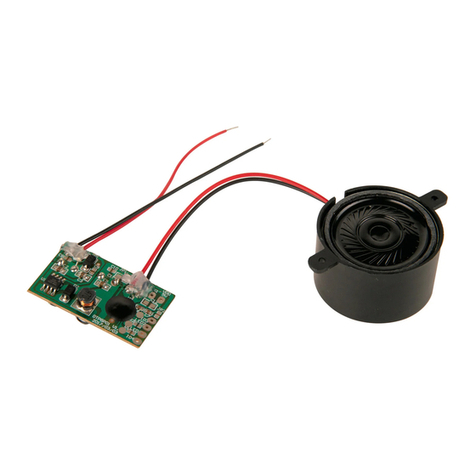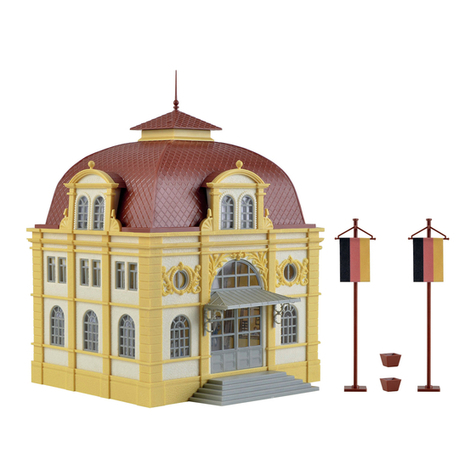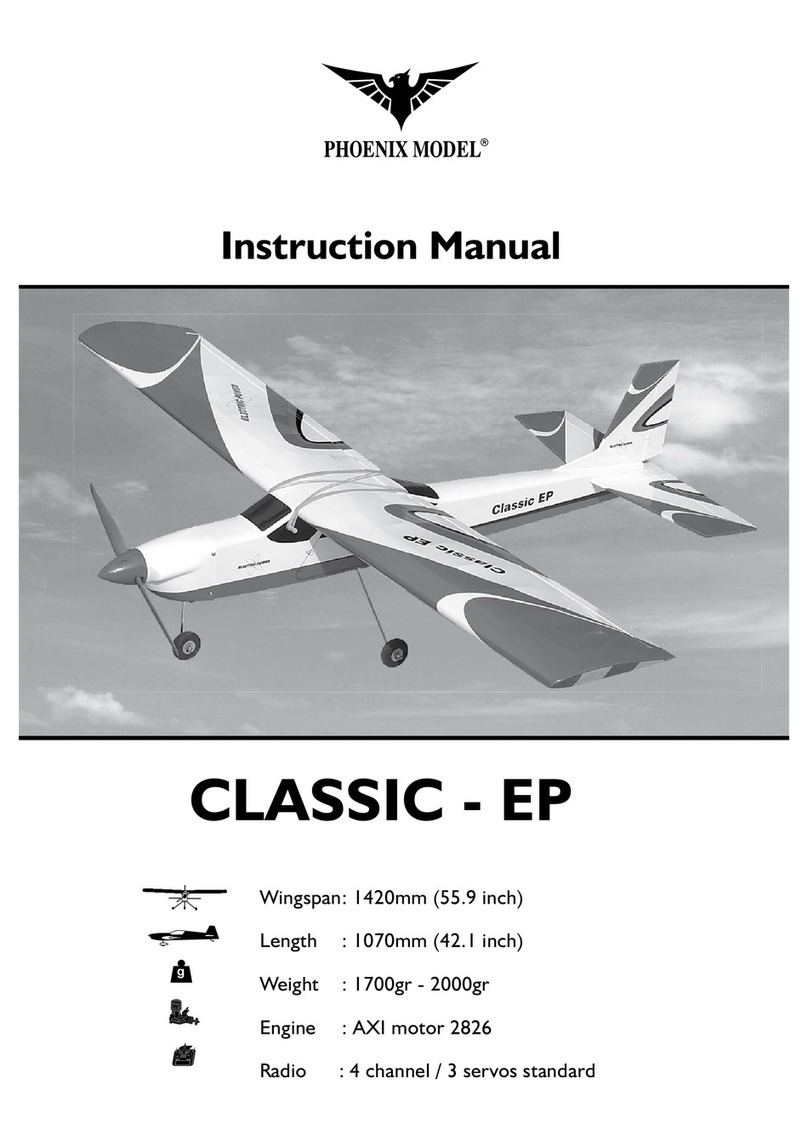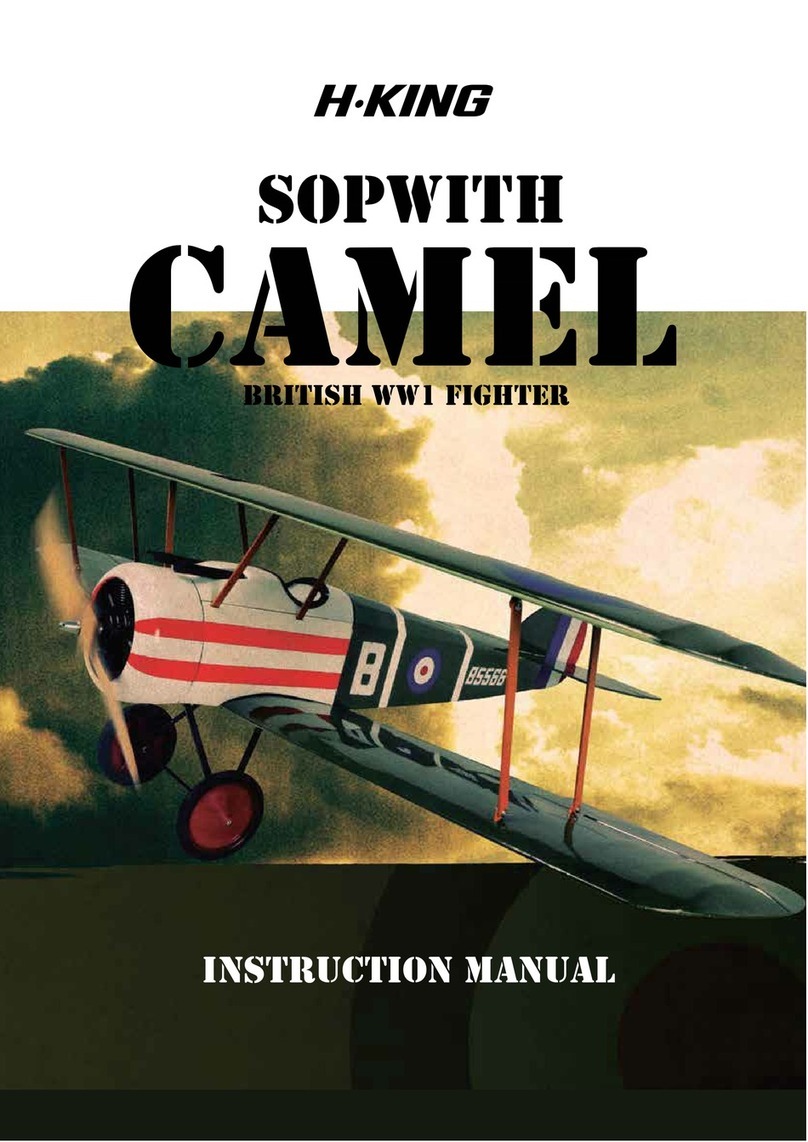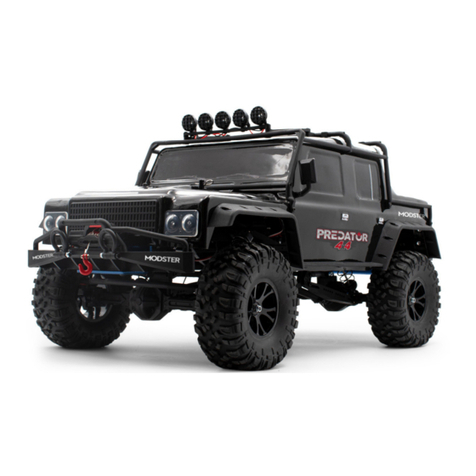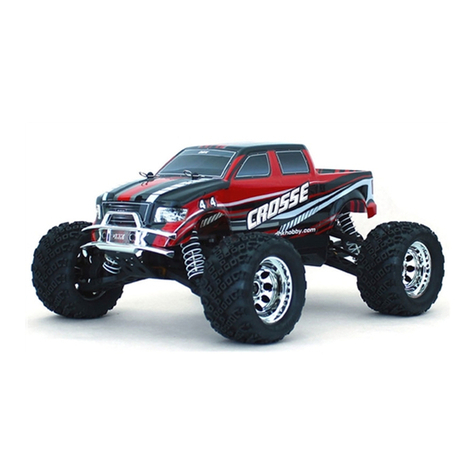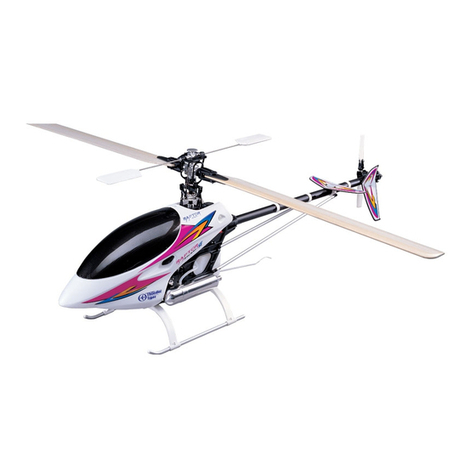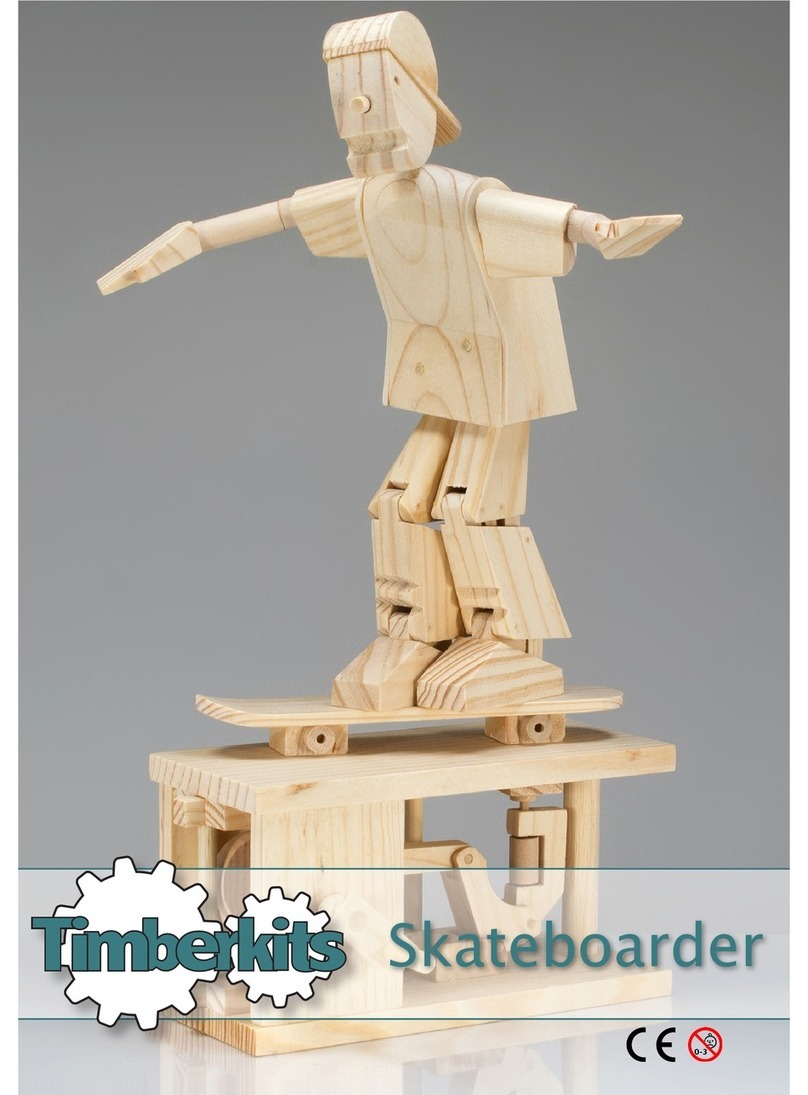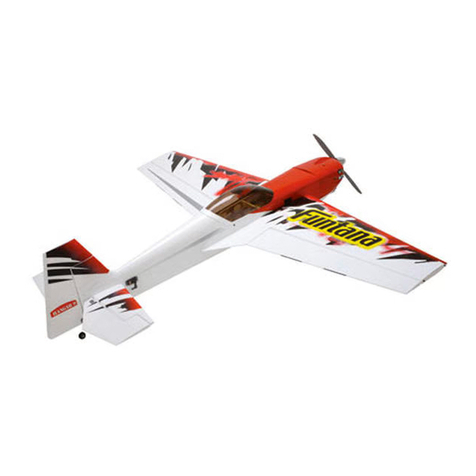TeemLosi XXX-4 Graphite Plus User manual

MADE IN THE UNITED STATES OF AMERICA
P/N 800-0208
4710 Gausti Rd., Ontario CA 91761
Phone: (909) 390-9 9 / Fax: (909) 390- 3 6
www.TeamLosi.com / feedback@TeamLosi.com
OWNER'S
MANUAL
Team losi, Division of Horizon Hobby inc.,
Carefully read through all instructions to familiarize yourself with the parts, construction techniques, and
tuning tips outlined in this manual. Being able to grasp the overall design of your new XXX-4 Graphite
Plus Buggy before beginning the construction process will ensure a smooth assembly.
ake your time and pay close attention to detail. Keep this manual for future reference.
10/01/2003
JAC/RWW

Welcome Team Losi XXX-4 Owner!
Thank you for selecting Tea Losi and the XXX-4 Graphite Plus as your new racing buggy. As you will see, we have
ade every effort to design and produce a kit that is not only the ost co petitve, but easy to build and aintain. The si ple
bag-by-bag asse bly sequence and un atched easy to follow instructions, co bined with Tea Losi's world fa ous quality-
fitting parts, should ake building your new XXX-4 Graphite Plus a ost enjoyable project.
Before you open the first bag or start any asse bly, please take a few o ents to read co pletely through the following
instructions. This will fa iliarize you with the various parts as well as the tools you will need. Taking an extra o ent before
starting can save you a good deal of ti e and assure proper asse bly.
Once again, thank you for choosing Tea Losi.
Good luck and good racing!
1. INTRODUCTION
XXX-4 GRAPHITE PLUS COMPLETED KIT DIMENSIONS
Overall Length: 1 -3/8" Front Width: 9-3/4" Rear Width: 9- /8" Height: -3/8"
Wheelbase: 10-3/4" All dimensions at ride height. Weight will vary depending on accessories.
Step A-1
i
NO ES & SYMBOLS USED
This is a common Step sequence found at the beginning of each
new illustration throughout the manual.
q1. Each step throughout the entire manual has a check box to the
left of it. As you complete each step, mark the box with a check. If you
need to take a break and return to building at a later time you will be
able to locate the exact step where you left off.
This is a common note. It is used to call attention to specific
details of a certain step in the assembly.
IMPORTANT NOTE: Even if you are familiar with Team
Losi kits, be sure and pay attention to these notes. They point out
very important details during the assembly process. Do not ignore
these notes!
In illustrations where it is important to note which
direction parts are facing, a helmet like this one will be included in the
illustration. The helmet will always face forward in the car as the
driver would. Any reference to the right or left side will relate to the
direction of the helmet.
The kit is composed of different bags marked A through H. Each
bag contains all of the parts necessary to complete a particular sec-
tion of the XXX-4 Graphite Plus. Some of these bags have subas-
sembly bags within them. It is essential that you open only one bag
at a time and follow the correct assembly sequence, otherwise you
may face difficulties in finding the correct part. It is helpful to read
through the instructions for an entire bag prior to beginning assem-
bly. Key numbers (in parenthesis) have been assigned to each part
and remain the same thoughout the manual. In some illustrations,
parts which have already been installed are not shown so that the
current steps can be illustrated more clearly.
For your convenience, an actual-size hardware identification
guide is included with each step. To check a part, hold it against the
silhouette until the correct part is identified. In some cases extra
hardware has been supplied for parts that may be easy to lose.
The molded parts in the XXX-4 Graphite Plus are manufactured
so that they interlock. When screws are tightened to the point of
being snug, the parts are held firmly in place. For this reason it is
very important that screws not be overtightened in any of the plastic
parts.
To ensure that parts are not lost during construction, it is recom-
mended that you work over a towel or mat to prevent parts from
rolling away.
1. Select an area for assembly that is away from the reach of small
children. Some parts in this kit are small and can be swallowed by
children, causing choking and possible internal injury.
2. The shock fluid and greases supplied should be kept out of
childrens' reach. They are not intended for human consumption!
3. xercise care when using any hand tools, sharp instruments,
or power tools during construction.
4. Carefully read all manufacturer's warnings and cautions for
any glues, chemicals, or paints that may be used for assembly and
operating purposes. When you are using glues, chemicals, and paints
you should always wear eye protection and a mask.
KI /MANUAL ORGANIZA ION
IMPOR AN SAFE Y NO ES

ii
OOLS REQUIRED
Team Losi has supplied all necessary Allen Wrenches and two special assembly wrenches that are needed for slipper adjustment, assembly and
Tierod adjustments. The following common tools will also be required: Needle-nose pliers, regular pliers, medium grit sandpapper, hobby knife,
scissors, and body cutting/trimming tools. A soldering iron may be necessary for electrical installation. 3/16", 1/4", and 11/32" nut drivers are
optional.
RADIO/ELEC RICAL
A suggested radio layout is provided in this manual. Your high-performance R/C center should be consulted regarding specific questions
pertaining to radio/electrical equipment.
HARDWARE IDEN IFICA ION
When in question, use the hardware identification guide in each step. For screws, the prefix number designates the screw size and number of
threads per inch (i.e. 4-40 is #4 screw with 40 threads per inch). The second number or fraction, designates the length of the screw. For cap head
and button head screws, this number refers to the length of the threaded portion of the screw. For flat head screws, this number refers to the
overall length of the screw. Bearings and bushings are referenced by the (inside diameter) x (outside diameter) (ie. 3/16 x 3/8). Shafts and pins
are referred to by diameter x length. Washers are described by inside diameter or the screw size that will pass through the inside diameter. E-clips
are sized by the shaft diameter that they attach to.
MO ORS AND GEARING
The XXX-4 G+ includes an 92-tooth, 48-pitch spur gear. The internal drive ratio of the XXX-4 G+ is 2.10. The pinion gear that is used will
determine the final drive ratio. To calculate the final drive ratio, first divide the spur gear size by the pinion gear size. For example, if you are using
a 20-tooth pinion gear, you would divide 92 (spur gear size) by 20 (pinion gear size). 92/20 = 4.60. This tells you that 4.60 is the external drive ratio.
Next, multiply the internal drive ratio (2.10) by the external drive ratio (in this case 4.60). 2.10 x 4.60 = 9.66:1. This means that by using a 20-tooth
pinion gear with the standard 92-tooth spur gear, the final drive ratio is 9.66:1.
Consult you high-performance shop for recommendations to suit your racing style and class. The chart below lists some of the more
common motor types and recommended initial gearing for that motor. Ratios can be adjusted depending on the various track layouts, tire sizes,
and battery types.
RECOMMENDED INITIAL GEARING FOR COMMON MOTORS
TYPE OF MOTOR PINION SPUR
24º (Depending on motor and track size) 17-20 92
8-Turn Modified 16 92
9-Turn Modified 17 92
10-Turn Modified 18 92
11-Turn Modified 19 92
12-Turn Modified 20 92
13-Turn Modified 21 92
14-Turn Modified 22 92
1 -Turn Modified 23 92
TABLE OF CONTENTS
1. INTRODUCTION ................................................................................ i
Completed Kit Dimensions .............................................................. i
Notes & Symbols .............................................................................. i
Kit/Manual Organization ................................................................. i
Important Safety Notes .................................................................... i
Tools Required ................................................................................. ii
Radio/Electrical ................................................................................ ii
Hardware Identification .................................................................. ii
Motors and Gearing ........................................................................ ii
2. BAG A ............................................................................................... 1-7
3. BAG B ...............................................................................................8-11
4. BAG C ..........................................................................................12-15
5. BAG D ........................................................................................ 1 -20
. BAG E ......................................................................................... 21-25
7. BAG F ......................................................................................... 2 -28
8. BAG G ................................................................................................ 29
9. BAG H ........................................................................................ 30-34
10. Checklist Before Your First Run ................................................ 35
11. Tips From the Team .................................................................. 35-37
12. Spare Parts List ........................................................................ 38-41
Team Losi is continually changing and improving designs; therefore, the actual part may appear slightly different than the illustrated part. Illustrations of parts and
assemblies may be slightly distorted to enhance pertinent details.

q 1. Locate the 1/16" Allen Wrench (125) supplied with the kit.
Place the Di Nut (27), "T" side irst, over the Allen Wrench towards
the "L"end.
Figure 1
q1. Locate the Di Nut (27).
q 2. Stack the six 1/8" Belleville Washers (154) over the Wrench
and up against the Di Nut. The Washers should all point the same
direction and open away rom the Di Nut as shown in Figure 2B.
Figure 2B
Figure 2A
Figure 3
q1. Insert all o the parts that are stacked on the Wrench (125) into
the Plastic Male Outdrive/Di Hal (19) (the one with the post). Line
up the tabs on the Di Nut (27) with the slots in the Male Outdrive.
Press the parts all the way into the Male Outdrive.
q1. Apply a small amount o Clear Di Grease (172) to the outside
ring o the Plastic Male Outdrive (19). Attach a Di Drive Ring (108)
to the Male Outdrive by lining up the "D" shape o the Drive Ring
with the "D" shape on the Outdrive.
*NOTE: Only a small amount of Clear Diff Grease is needed. It
is only used to hold the Drive Ring in pla e.
Figure 4
IMPORTANT NOTE: Do not glue the Drive Rings to the
Outdrive/Di Halves. Doing so may not allow the Rings to mount lat
on the Outdrive.
STOP! There are two, complete Differential assemblies in the -4 G+ kit. The Front - Plastic Differential, shown in steps A-
1 thru A-9 and The Rear - Steel Differential, shown in steps A-10 thru A-19. The -4 G+ kit was designed using the stock 42T
Drive Pulleys in the front and rear of the car. There is an optional 41T Pulley included in Bag H of this kit, this feature can be used
to apply under-drive or over-drive in the vehicle. See "Final Checklist" at the end of this manual.
BAG A
1
Step A-1
Step A-2
Step A-3
Step A-4
Diff Nut Carrier:
Diff Nut With Belleville Washers:
Diff Nut to Male Outdrive:
Diff Drive Ring to Male Outdrive:
154
19
108
CLEAR DIFF
GREASE (172)
125
19
27
27
125
154

BAG A (Continued)
2
Step A-5
Step A-6
Figure 5
q1. Insert a 5mm x 8mm Bearing (117) into the center o the 42T Di
Pulley (42).
q2. Press a 3/32" Di Ball (82) into each o the twelve small holes
in the Di Pulley as indicated in Figure 5.
117
82
q1. Apply a moderate coat (continuous bead) o Clear Di Grease
(172) to the exposed side o the Di Ring (108) that is already at-
tached to the Male Outdrive (19).
q 2. Care ully place the Di Pulley (42) over the post on the
Outdrive so that the Di Balls (82) and Di Pulley rest against the
Greased Drive Ring. Leave the assembly with the 1/16" Allen Wrench
(125) standing as shown in Figure 6.
Diff Pulley:
Diff Pulley to Male Outdrive:
82
42
117
108
42
82
CLEAR DIFF
GREASE (172)
19
Figure 6

Step A-7
Step A-9
Step A-8
3
BAG A (Continued)
q1. Press a 5mm x 8mm Bearing (117) into the center area o the
Female Plastic Outdrive/Di Hal (20) as indicated. The edge o the
Bearing should be lush with the ront o the Outdrive.
q2. Apply a small amount o Clear Di Grease (172) to the outer
ring o the Outdrive. Install the second Drive Ring (108), again align-
ing the "D" shape o the Outdrive and the Drive Ring. Figure 7
91
149
95
q1. Place the oam Thrust Bearing Seal (186) over the shoulder o
the Di Adjusting Screw (91).
q2. Place one o the 3mm x 8mm Thrust Bearing Washers (149)
over the Di Screw.
q3. Using the MIP RED Grease (157), apply a airly heavy coat o
Grease to the Thrust Washer and position the eight 5/64" Thrust
Balls (95) in a circular pattern around the Di Screw. Apply another
coat o RED MIP Grease over the Thrust Balls and place the second
Thrust Bearing Washer over the Di Screw and up against the Thrust
Balls.
q4. Insert the Di Screw into the Female Outdrive (20). Pull the
threaded end o the Di Screw until the Thrust assembly rests against
the inside o the Outdrive.
Figure 8
Figure 9
q1. Care ully replace the Allen Wrench (125) rom the Male Outdrive
(19) with a pen or pencil, and place it in the slot o the Female Outdrive
(20) containing the Di Screw (91). The pen will be used to hold the
Di Nut (27) assembly in the bottom side.
q2. Apply a good amount o Clear Di Grease (172) (enouth to
cover the Balls completely) to the exposed side o the Balls in the Di
Pulley (42) on the Male Outdrive.
q3. While holding the Female Outdrive with Allen Wrench inserted,
care ully assemble it to the Male Outdrive.
q4. Make sure that the slot in the Di Screw is lined up with the
slot in the Female Hal and then while holding the Male Hal slowly
turn the Female Outdrive until the threads o the Di Screw engage
on the threads o the Di Nut. Remove the pencil rom the Male Hal
and thread the two Outdrives together until the Screw just starts to
snug up.
q5. Tighten the Di until the Pulley (42) cannot be turned while
both o the Outdrives are being held irmly. Final Di adjustment
should be made a ter completion o the XXX-4 G+.
When tightening the Diff, tighten the S rew a little and then
"work" the Diff a little. Then tighten the S rew a little more and
"work" the Diff again. Continue this until the Diff Gear doesn't slip
while holding the Outdrives. This ensures that the parts in the Diff
are properly seated. Refer to Te h Tips for final adjustment. "Work-
ing" the Diff is done by rotating the Outdrives in opposite dire -
tions.
Bearing to Female Outdrive:
Female
Outdrive Assembly:
Male to Female Outdrive Assembly:
PENCIL
108
125
27 19
42
20
91
CLEAR DIF
F
GREASE
(172)
186
117
108
20
117
186
149
91
95
20
GREASE
MIP RED
(157)

4
BAG A (Continued)
Step A-10
qLocate the Di Nut (27).
Diff Nut Carrier:
Figure 10
Step A-11
Figure 11A
q 1. Locate the 1/16" Allen Wrench (125) supplied with the kit.
Place the Di Nut (27), "T" side irst, over the Allen Wrench towards
the "L-end."
q 2. Stack the six 1/8" Belleville Washers (154) over the Wrench
and up against the Di Nut. The Washers should all point the same
direction and open away rom the Di Nut as shown in Figure 11B.
Step A-12
Figure 12
q1. Insert all o the parts that are stacked on the Wrench (125) into
the steel Outdrive/Di Hal (87). Line up the tabs on the Di Nut (27)
with the slots in the Outdrive. Press the parts all the way into the
Outdrive, so that the Di Tube (86) is seated inside the Outdrive.
Diff ube Assembly to Outdrive:
Diff ube Assembly:
Step A-13
q1. Apply a small amount o Clear Di Grease (172) to the outside
ridge o the Outdrive/Di Hal (87). Attach a Di Drive Ring (108) to
the Outdrive by lining up the "D" shape o the Di Ring with the "D"
shape o the Outdrive.
*NOTE: Only a small amount of Grease is needed. It is only
there to hold the Diff Ring in pla e.
IMPORTANT NOTE: Do not glue the Di Ring to the
Outdrive/Di Halves. Doing so may not allow the Rings to mount lat
on the Outdrive.
Diff Drive Ring to Male Outdrive:
q 3. Place the Di Tube (86) over the Wrench, large side irst, so
that it rests against the Belleville Washers as shown in Figure 11A.
86
IMPORTANT NOTE: Male Outdrive de ined as: Outdrive
containing Di Tube assembly (Figure 11A). Female Outdrive de-
ined as: Outdrive containing Thrust assembly (Figure 17).
87
108
SMALL AMOUNT
OF CLEAR DIFF
GREASE (172)
108
Figure 13
Figure 11B
154
27
86 154
125
27
87
86
27

BAG A (Continued)
Step A-14
q1. Insert a 5mm x 8mm Bearing (117) into the center o the 42T Di
Pulley (42).
q2. Press a 3/32" Di Ball (82) into each o the small holes in the
Di Pulley as indicated in Figure 14.
Diff Pulley:
117
82
Figure 14
Step A-15
q1. Apply a moderate coat (continuous bead, same as step A-9) o
Clear Di Grease (172) to the exposed side o the Di Ring (108) that
is already attached to the Male Outdrive (87).
q 2. Care ully place the Di Pulley (42) over the post on the
Outdrive so that the Di Balls (82) and Di Pulley rest against the
Greased Di Ring. Leave the assembly with the 1/16" Allen Wrench
(125) standing as shown in Figure 15.
5
FIGGIGUREFASDF
82
42
117
Diff Pulley to Diff ube:
108
42 82
CLEAR DIFF
GREASE (172)
87
Figure 15

BAG A (Continued)
q1. Insert a 5mm x 8mm Bearing (117) into the second Outdrive/
Di Hal (87). Make sure that the Bearing is pushed all the way into
the Outdrive. A pencil or the handle o a hobby kni e can be used to
push the Bearing into place.
q 2. Apply a slight amount o Clear Di Grease (172) to the
1/4" x 5/16" Shim (153). Insert the Shim into the Outdrive/Di Hal
next to the 5mm x 8mm Bearing. Make sure that the Shim is lat against
the Bearing. Be extra areful not to bend this Shim!
*NOTE: Only a small amount of Grease is needed. It is only
needed to hold the Shim in pla e next to the Bearing.
Step A-16 Female Outdrive Bearing Install:
q1. Locate the Di Adjusting Screw (91) and place the Foam Thrust
Bearing Seal (186) over the shoulder o the Screw.
q2. Place one o the 3mm x 8mm Thrust Bearing Washers (149)
over the Di Screw.
*NOTE: The Thrust Bearing Washers are pa kaged in a small
bag along with the eight 5/64" Thrust Bearing Balls.
q3. Grease the Thrust Washer well with MIP RED Thrust Bearing
Grease (157) and place the eight 5/64" Thrust Bearing Balls (95) on
top o the Washer, around the Di Screw. Apply more RED Thrust
Bearing Grease to the tops o the Thrust Bearing Balls. Place the
second Thrust Washer over the Screw and against the Thrust Bear-
ing Balls.
q 4. Very care ully insert the Di Screw, with the Thrust Bearing
assembly installed, into the Female Outdrive (87). Be very care ul not
to bend or pinch the Shim (153) while inserting the Di Screw. Pull the
threaded end o the Di Screw until the Thrust Bearing assembly
rests against the Shim and Bearing (117) inside o the Outdrive.
IMPORTANT NOTE: Ensure that all eight Thrust Bearing
Balls remain in place between the two Washers, around the Di Screw.
Step A-17 Diff Adjusting Screw Assembly:
6
91
186
149
95
153
117
Figure 16
Figure 17
91
95
87
186
149
157
MIP RED
THRUST BEARING
GREASE
87
153
117

Step A-18
BAG A (Continued)
7
q1. Locate the smallest o the Allen Wrenches, 0.050 (128), and
place it through the slot in the Outdrive/Di Hal (87) containing the
Di Screw (91). Slide the Wrench all the way against the Screw. By
handling the Outdrive/Di Hal with the Wrench inserted, the Di
Screw will be held in place while inishing the assembly o the Di er-
ential.
q2. Apply a small amount o Clear Di Grease (172) to the outer
ridge o the Outdrive. Install the remaining Di Ring (108), again
lining up the "D" shape o the Outdrive/Di Hal with the "D" shape
o the Ring.
IMPORTANT NOTE: Do not glue the Di Rings to the
Outdrive/Di Halves. Doing so may not allow the Rings to mount lat
on the Outdrive.
Diff Drive Ring to Female Outdrive:
Step A-19
q1. Care ully replace the Allen Wrench (125) with a pen or pencil
rom the Male Outdrive (87). The pen will be used to hold the Di Nut
(27) assembly in the bottom side.
q2. Apply a airly heavy coat o Clear Di Grease (172) to the
exposed side o the Di Ring (108) on the Female Outdrive.
q3. While holding the Female Outdrive with Allen Wrench inserted,
care ully assemble it to the Male Outdrive.
q4. Make sure that the slot in the Di Screw is lined up with the
slot in the Female Hal and then while holding the Male Hal , slowly
turn the Female Outdrive until the threads o the Di Screw engage
on the threads o the Di Nut (27). Remove the pencil rom the Male
Hal and thread the two Outdrives together until the Screw just starts
to snug up.
q5. Tighten the Di until the Pulley (42) cannot be turned while
both o the Outdrives are being held irmly. Final Di adjustment
should be made a ter completion o the XXX-4 G+.
When tightening the Diff, tighten the S rew a little and then
"work" the Diff a little. Then tighten the S rew a little more and
"work" the Diff again. Continue this until the Diff doesn't slip while
holding the Outdrives. This ensures that the parts in the Diff are
properly seated. Refer to Te h Tips for final adjustment. "Working"
the Diff is done by rotating the Outdrives in opposite dire tions.
Outdrive Assembly:
Figure 18
Figure 19
PENCIL
108
27 87
42
87
CLEAR DIF
F
GREASE
91
(172)
128
108
87
91
108
128
SMALL AMOUNT
OF CLEAR DIFF
GREASE (172)

77
29
46
116
110
152
44
98
146
Step B-2
q1. Snap a 3/16" x 3/8" Bearing (116) into the right side of the Idler
Pulley ( ). The Bearing will snap past the ridge and stop.
q2. Place the Idler Pulley Shaft (98) through the Idler Pulley from
the Bearing side.
q3. Slide a # x .020 Washer (152) over the - 0 x 5/16" Button
Head Screw (1 6).
q. Insert the - 0 x 5/16" Button Head Screw through the Idler
Pulley and thread it into the Belt Tensioner Arm (110) positioned as
shown in Figure 20.
Figure 21
Figure 20
BAG B
8
152
116
146
98
q 1. Position the Chassis ( 6) upside-down on your work bench.
Insert the Belt (77) and pull it through both ends of the Chassis.
q2. Pull the Belt out, just slightly, through the bottom of the Chas-
sis and insert the Steering Tunnel (29), tall end forward, into the slot
in the front of the Chassis. Press into position as indicated in Figure
21.
The Steering Tunnel should now be located in between the
Belt, with the Belt still slightly hanging out of both ends of the car.
Step B-1
*NEVER PINCH THE BELT*
NEVER OVER TIGHTEN THE SCREWS IN THE
CHASSIS - Team Losi has designed inter ocking
features into the XXX-4 G+ Chassis. On y tighten the
Screws to the point of being snug, so the parts are he d
firm y in p ace.
Tensioner Arm Assembly:
Belt Installation:

BAG B (Continued)
Figure 22
9
Note:Use the Plastic Diff assembly for the Front of the
-4 G+.
There is a short Thread-Cutting Screw included in the Wrench
bag. This Screw can be used to tap threads in the holes in the Main
Chassis and the bottom of the Diff Covers. Pre-tapping these holes
makes it easier to install the Screws during assembly.
q1. Slide one 1/2" x 3/ " Bearing (118) over each of the Outdrive
Cups (19),(20) with the teflon seal facing away from the Diff Pulley
( 2).
q2. Pull the Belt (77) slightly out through the front of the Chassis
( 6) and install a Diff assembly into the slots as indicated in Figure 22.
Pull the slack from the Belt through the rear of the Chassis.
The head of the Diff Adjustment Screw should always be on
the drivers left side of the Chassis.
q3. Secure the Diff assembly by installing the front Diff Cover (62)
with two - 0 x 1/2" Cap Head Screws (129) through the Diff Cover
into the two counter-bored holes in the Chassis.
q. Flip the Chassis over and install the two - 0 x 3/8" Flat Head
Screws (13 ) through the bottom of the Chassis into the front Diff
cover as indicated in Figure 22.
134
134
Step B-3 Front Diff
Install:
Step B-4 Rear Diff Install:
129
20
42
62
129
77
46
134
SIDE WITH
DIFF NUT (27)
118
19
129
118
118
129
87
69
77 42
46
134
87
118
SIDE WITH
DIFF NUT (27)
Figure 23
Note: Use the Steel Diff assembly for the rear of the -4 G+.
There is a short Thread-Cutting Screw included in the Wrench
bag. This Screw can be used to tap threads in the holes in the Main
Chassis and the bottom of the Diff Covers. Pre-tapping these holes
makes it easier to install the Screws during assembly.
q1. Slide one 1/2" x 3/ " Bearing (118) over each of the Outdrive
Cups (87),(87) with the Teflon Seal facing away from the Diff Pulley
( 2) on the remaining Differential.
q2. Spread the Belt (77) apart and install the Diff assembly into the
slots of the Chassis ( 6) as indicated in Figure 23. Once the Diff
assembly is in place, pull the slack up through the center of the Chas-
sis from the top side.
Once again, the head of the Diff Adjustment Screw should be on
the drivers left side of the Chassis.
q3. Secure the Diff assembly by installing the rear Diff Cover (69)
with two - 0 x 1/2" Cap Head Screws (129) through the Diff Cover
into the counter-bored holes in the rear of the Chassis.
q. Flip the Chassis over and install the two - 0 x 3/8" Flat Head
Screws (13 ) through the bottom of the Chassis into the rear Diff
Cover as indicated in Figure 23.

96
71
99
156
106 104
123
196
70
119
119
155
105
197
103
Tighten
BAG B (Continued)
Step B-6
Figure 25
Step B-5
10
99
96
146
151
q1. While holding the Slipper Clutch assembly, with your thumb
and index finger, pull the Belt (77) up through the Chassis ( 6) and
insert the assembly into the large opening in the top of the Chassis
lining up the Top Shaft (99) with the holes in the Chassis.
q2. Place a # Hardened Washer (151) over a - 0 x 5/16" Button
Head Screw (1 6) and thread it through the left side of the Chassis
into the Top Shaft.
You may need to slightly pinch the Chassis to install the 4-40 x
5/16" Button Head Screws.
q3. Once again, place a # Hardened Washer over a - 0 x 5/16"
Button Head Screw and thread it through the Chassis into the right
side of the Top Shaft.
Leave the right side Screw a bit loose until the Belt Tensioner is
installed.
IMPORTANT NOTE: Never pinch the Belt, as it will result
in a shorter life of the Belt and cause your vehicle to stop runnin !
Slipper Clutch Assembly:
Slipper Clutch Insert:
119
106
77
46
99
71
146 151
Figure 24A
Figure 24B
q 1. Press a 3/16" x 5/16" Bearing (119) into the Slipper Hub (103)
from the outside/large face. Slide the Top Shaft (99) through the Bear-
ing in the Slipper Hub.
q 2. Place the Spur Gear (71) onto the Slipper Hub and place all six
of the Slipper Pucks (156) into the holes in the Spur Gear.
q 3. From the "Drive Pulley" (70) side of the Slipper Clutch assem-
bly, slide the Slipper Bearing Spacer (106) over the Top Shaft. Place
the second 3/16" x 5/16" Bearing over the Top Shaft and press the
Bearing into the Slipper Hub.
q . Place the flat face of the Slipper Plate (10 ) against the Slipper
Pucks in the Spur Gear. Then press the 6 pins of the Drive Pulley (70)
through the holes in the Slipper Plate continuing through the center
hole of the Spur Gear and into the 6 holes in the Slipper Hub.
q 5. Insert A Slipper Spring Shim (155) followed by the Slipper Wave
Spring (123), then another Slipper Spring Shim, into the Slipper Drive
Pulley and thread the Slipper Flange (105) Counter Clockwise onto
Slipper Hub until it is "finger tight". Place one .005 Shim (196) and
one 0.015 Shim (197) on the Top Shaft next to the Bearing. Slide the
Tensioner Bushing (96), large side toward Slipper Hub, over the Top
Shaft, against the Shims.
q 6. The Slipper Wrench will be used for the final adjustment of the
Clutch assembly in the Final Checklist section in the back of this
manual.
196 197
Slipper Wrench

q1. Slide the Tensioner Arm assembly (110) down over the Belt (77) and connect the slot in the Tensioner Arm with the Slipper Clutch
assembly's Belt Tensioner Bushing (96) as indicated in Figure 26A.
q2. Slowly start rotating the Tensioner Arm assembly around the Belt Tensioner Bushing in a clockwise direction as shown in Figure 26B.
While rotating the Tensioner Arm assembly, slightly pull upward to keep the Tensioner Arm locked and rotating around the Belt Tensioner
Bushing. The Belt should be positioned between the Slipper Drive Pulley (70) and the Tensioner Arm.
q3. Place a # Hardened Washer (151) over a - 0 x 5/16" Button Head Screw (1 6).
q. Once you have the belt wrapped around the Slipper Drive Pulley, and Belt Tensioner is in position, as shown in Figure 26C, secure the
Tensioner assembly by threading the - 0 x 5/16" Button Head Screw, with Washer through the Chassis ( 6) and into the upper hole in the
Tensioner Arm. With the Screw about one turn loose, push down on the flat part of the Tensioner and set the desired Belt tension, tighten the
Screw.
The belt should move 1/8" ( mm) to 1/4" (7.5mm) up and down for the ideal tension.
46
145
61
77
70
44
BAG B (Continued)
Step B-8
Step B-7
11
q1. With the Chassis facing upside down, seal the drivetrain by
placing the Bottom Chassis Cover (61) with the flat side towards the
Bottom of the Chassis ( 6). Secure the Bottom Chassis Cover with
seven 2-56 x 3/16" Flat Head Screws (1 5).
Figure 27
Figure 26B
151
146
Tensioner Arm Installation:
Bottom Cover Installation:
145
96
77
110
46
110
151
146
Figure 26C
Figure 26A

97
31 30
32
29
46
134
30
142
81
10
0
LARGE HOLES
FORWARD
81
117
117
32
31
Step C-1
Step C-2
q1. Thread a 3/16" Ball Stud (81), from the top side, into each of the
Left (3 ) and Right (31) Bellcranks.
q2. Insert a 5mm x 8mm Bearing (117) into the top and bottom of
the Left and Right Bellcranks.
q3. Thread a 3/16" Ball Stud (81) into the small hole in the Draglink
(32).
q4. Insert the 2 Carrier/Steering Bushings (1 ), into the bottom
side of the Draglink and then rest it on the top of the Left and Right
Bellcranks.
q5. Thread a 4-4 x 3/8" Button Head Screw (142) through each
Steering Bushing and into the Bellcranks.
Figure 28
Figure 29
BAG C
12
q1. Line up the hex of a Steering Post (97) with the rear hex area on
left side of the Chassis (46). Press the Steering Post to the bottom of
the hex. Thread a 4-4 x 3/8" Flat Head Screw (134) through the bot-
tom of the Chassis and into the Steering Post.
q2. Repeat Step 1 for the right side Steering Post.
q3. Slide the Bellcrank assembly from Step C-1 through the Steer-
ing Tunnel (29) and then slide the Left Bellcrank (3 ) over the Steer-
ing Post on the left side of the Chassis.
q4. Sliding the Right Bellcrank (31) over the right Steering Post will
need to be done at the same time as the Left Bellcrank.
The Bellcranks should rotate freely.
81 14
2
Steering Bellcrank Assembly:
Steering Install:
13
4
11
7

64
30
137
BAG C (Continued)
StepC-3
Step C-4
Figure 31
Figure 30
13
q1. Thread a 4-4 x 5/8" Set Screw (137) into a Front Body Mount
(64) until it bottoms out in the hole.
q2. Thread the Body Mount into the left Steering Post (97), tighten
until snug and the cross hole is positioned lengthwise with the Chas-
sis.
q3. Repeat steps 1 and 2 for the right Body Mount.
The Steering assembly should rotate freely. Be sure that the
Mounts are not too loose but, not too tight.
All standard servos should use only one Silver Spring and one
Gold Spring. All hi-tor ue & high-speed servos will use all three
Springs.
q1. Using Table 31B (on the following page), determine which
Servo Saver Base (36) is required for your Servo. If your particular
servo is not listed, try using the Base recommended for another servo
made by the same manufacturer.
q2. Thread a 3/16" Ball Stud (81) into the outer Servo Saver Arm
(39) from the front side as indicated in Figure 31.
q3. Plug the servo into the radio system's receiver (not included).
Make sure that there is power to the receiver, and turn the transmitter
on, followed by the receiver. Be sure that the trim settings for the
steering on your transmitter are set to the center. With the radio sys-
tem still turned on, attach the Servo Saver Base to the output shaft of
the servo so that the Base is vertical as shown in Figure 31.
q4. Turn off your radio, slide one of the two "silver" Servo Saver
Springs (111) over the Servo Saver Base which is connected to the
servo. Fit the second of the "silver" Springs over the first Spring
followed by the "gold" Spring (112). The Springs should all be pressed
against the back of the Servo Saver Base.
q5. Press the Outer Servo Arm into the Servo Saver Base. Insert
the Servo Saver Washer (4 ) into the Outer Servo Saver Arm. Secure
the assembly to the servo with the Servo Arm screw supplied with the
servo.
137
64
Front Body Mount Install:
Servo Assembly:
81
S
CREW
S
UPPLIED WITH
S
ERVO
36
39
81
40
112
111

151 131
46
34
35
AIRTRONICS
ALL
FUTABA
FUTABA
S3401, S9402, S9404, S9450
HiTech
ALL
JR
JR
Z4750, Z8450
KO
PS-702, PS-703, PS-1001, PS-1003
KO
PS-901BH, PS-902
MULTIPLEX
ALL
NARROW 23
WIDE
NES-507, NES-513, NES-517, NES-901, NES-4000,
NES-4131, NES-4721, NES-4735, NES-9021, DS-
23
23
23
23WIDE
WIDE
NARROW
NARROW
SERVO TYPE OFFSET
NARROW
NARROW
NARROW
23
24
25
REQUIRED
SERVO ARM
S131, S131SH, S148, 23001, S3003, 25101, S9101,
S9201, S9304, S9401, S9403
25
BAG C (Continued)
Step C-5
Figure 32
WIDE
NARROW
Table 31A
Table 31B
14
q1. Use Figure 31A and Table 31B to determine how the Servo
Mounting Posts (34) and (35) should be attached to the servo (not
included), either in the "wide" or "narrow" position.
q2. Place a #4 Washer (151) over each of the four 4-4 x 3/8" Cap
Head Screws (131) and attach the Servo Mounts to the servo by
threading a Screw with Washer through the servo mounting ears into
the upper and lower holes in each Mount. Do not tighten the screws
yet! Just snug them up so that the Mounts are held in place, but can
still be moved from side to side with a little resistance.
q3. As shown in Figure 32, you will use the bottom side of the
Chassis to determine the exact spacing needed for your brand servo.
With the Scerws still loose, push the pins on the Servo Mounts into
the holes in the bottom of the Chassis (46). Slide the Mounts until the
Screws are centered on the servo, and tighten as indicated in Figure
32.
The servo should be as close to centered between the two
Mounts, and as low to the Chassis as possible.
1
5
1
131
Servo Mounting Post Install:

BAG C (Continued)
Figure 33
Figure 35
Figure 34B
Figure 34A
15
q1. Thread a Short Plastic Rod End (1 ) onto each end of the 4-4
x 5/8" Set Screw (137). Tighten both sides equally until the Rod is the
same length as the one shown in Figure 34B.
q1. Attach one Rod End (1 ) to the Ball Stud (8 ) in the Servo
Saver Arm (39), and the other to the Ball Stud in the Drag Link (32), as
indicated in Figure 35.
Step C-6 Servo Install:
q1. Install the servo onto the Chassis (46). The pins from both
Servo Mounting Posts (34), (35) should fit into the holes and sit flat
against the Chassis.
q2. Secure the servo to the Chassis with two 4-4 x 3/8" Flat Head
Screws (134).
Step C-7
137
10
137
10
Step C-8 Servo Link Install:
13
4
10
80
32
137
39
81
46
3
4
134
Servo Link:

135
62
53
47
49
50 101 194
195
46
46
47
134
16
Step D-1
Step D-2
q 1. Install the front left Inner Pivot Block (47) by threading two 4-40
3/8" Flat Head Screws (134) through the bottom of the Chassis (46)
into the Pivot Block as indicated in Figure 36. Repeat for the right
front Inner Pivot Block (48).
The left & right Inner Pivots are marked with "L" & "R".
BAG D
135
134
Front Inner Pivot Install
Front Arm Install
Figure 37A
Figure 36
194
195
q 1. Slide a 1/8" inner Hinge Pin (101) through the larger holes of
each of the two Front Arms (53) at the same time passing through the
Hinge Pin Retainer (194) positioned as shown in Figure 37B.
q 2. Position the Arm so that the shock mount hole faces the front
of the Chassis (46). Place one Pivot Ball (49) on the rear of each Hinge
Pin and insert the Arm into the front Inner Pivot Blocks (47) L, (48) R.
Capture the Front Arms by placing the front Main Block (50) marked
with "7.5F" onto the inner Hinge Pins as shown in the illustration in
Figure 37B. Secure the front Main Block by threading two 4-40 1/2"
Flat Head Screws (135) through the Main Block into the holes in the
front Diff Cover (62).
q 3. After securing the front main block, thread a 5-40 1/8" Set
Screw (195) into the Hinge Pin Retainer and tighten to secure the
Hinge Pin.
Figure 37B
ASSEMBLE MAIN BLOCK
IN THIS DIRECTION
Note: The Arm should rotate freely on the
inge Pin and not in the front Main Block or the
Pivot Balls. If the Arm does not pivot freely, use a
small file to remove a small amount of material
from the Arm where the inge Pin Retainer rests
against it.
101

46
52
131 152
182
52
183
130
33
BAG D (Continued)
17
Step D-3
Step D-4
q1. Insert a 4-40 3/4" Cap Head Screw (130) on either side of the
Shock Tower (52) through the middle hole on the top of the Shock
Tower. Secure the Screws to the Tower by threading a 4-40 Zinc Nut
(182) over each Screw and tightening.
q2. Thread a 3/8" Short Neck Ball Stud (33) through the inner and
upper-most of the lower five holes on either side of the Shock Tower,
and secure it with a 4-40 Mini Nut (183).
The Ball Studs should pass through the Tower from the same
direction as the Cap ead Screws.
182
There is a short Thread-Cutting Screw included in the Wrench
bag. This Screw can be used to tap threads in the holes in the Main
Chassis. Pre-tapping these holes makes it easier to install the Screws
during assembly.
q 1. Slide a .250 .020 Washer (152) over four 4-40 3/8" Cap Head
Screws (131).
q 2. Attach the Front Shock Tower (52) to the front of the Chassis
(46) with the four Screws. The Screws thread into the top-most and
bottom-most holes, surrounding the posts, which stick out of the
front of the Chassis. The Shock Tower should interlock with the posts
on the Chassis.
Front Shock Tower
Front Shock Tower Install
130
Figure 38
Figure 39
183
131
152
33
Table of contents
Popular Toy manuals by other brands
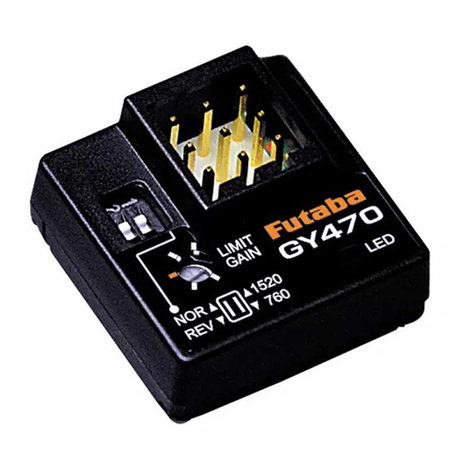
FUTABA
FUTABA GY470 instruction manual

LEGO
LEGO 41116 manual

Fisher-Price
Fisher-Price ColorMe Flowerz Bouquet Maker P9692 instruction sheet
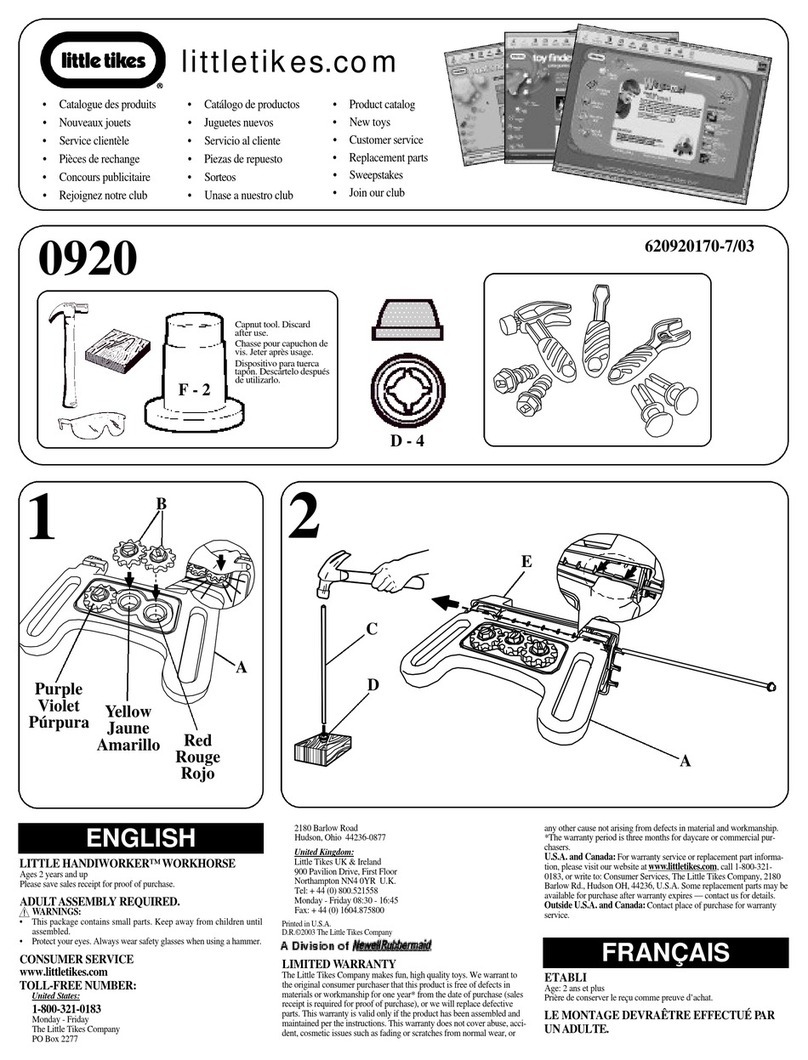
Little Tikes
Little Tikes LITTLE HANDIWORKER 0920 Assembly instructions

Eduard
Eduard EF-2000 Two-seater exterior Assembly instructions
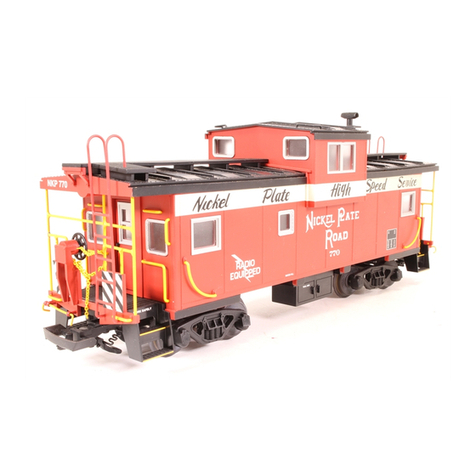
USA Trains
USA Trains EXTENDED VISION CABOOSE instructions

